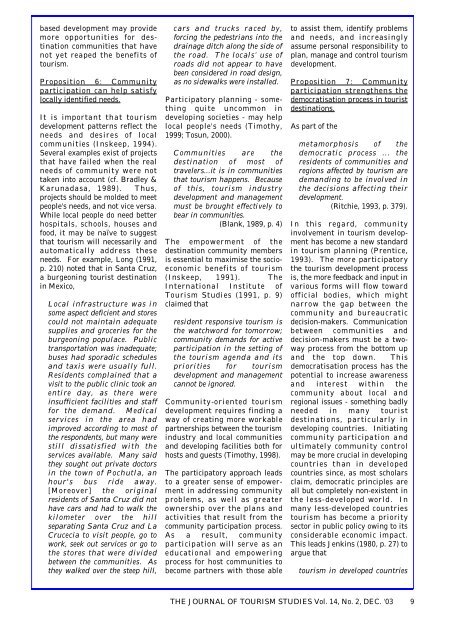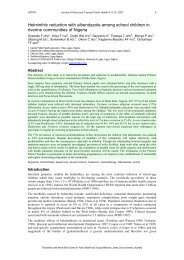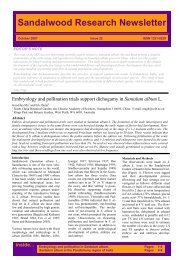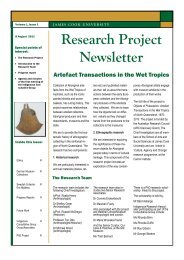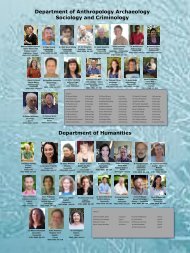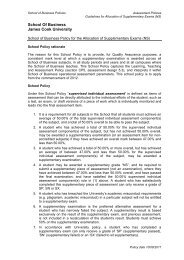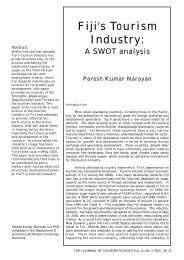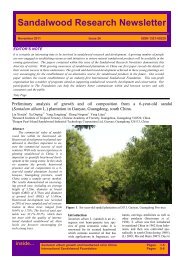Tosun Timothy
Tosun Timothy
Tosun Timothy
Create successful ePaper yourself
Turn your PDF publications into a flip-book with our unique Google optimized e-Paper software.
ased development may provide<br />
more opportunities for destination<br />
communities that have<br />
not yet reaped the benefits of<br />
tourism.<br />
Proposition 6: Community<br />
participation can help satisfy<br />
locally identified needs.<br />
It is important that tourism<br />
development patterns reflect the<br />
needs and desires of local<br />
communities (Inskeep, 1994).<br />
Several examples exist of projects<br />
that have failed when the real<br />
needs of community were not<br />
taken into account (cf. Bradley &<br />
Karunadasa, 1989). Thus,<br />
projects should be molded to meet<br />
people's needs, and not vice versa.<br />
While local people do need better<br />
hospitals, schools, houses and<br />
food, it may be naïve to suggest<br />
that tourism will necessarily and<br />
automatically address these<br />
needs. For example, Long (1991,<br />
p. 210) noted that in Santa Cruz,<br />
a burgeoning tourist destination<br />
in Mexico,<br />
Local infrastructure was in<br />
some aspect deficient and stores<br />
could not maintain adequate<br />
supplies and groceries for the<br />
burgeoning populace. Public<br />
transportation was inadequate;<br />
buses had sporadic schedules<br />
and taxis were usually full.<br />
Residents complained that a<br />
visit to the public clinic took an<br />
entire day, as there were<br />
insufficient facilities and staff<br />
for the demand. Medical<br />
services in the area had<br />
improved according to most of<br />
the respondents, but many were<br />
still dissatisfied with the<br />
services available. Many said<br />
they sought out private doctors<br />
in the town of Pochutla, an<br />
hour's bus ride away.<br />
[ M o r e o v e r ] the original<br />
residents of Santa Cruz did not<br />
have cars and had to walk the<br />
kilometer over the hill<br />
separating Santa Cruz and La<br />
Crucecia to visit people, go to<br />
work, seek out services or go to<br />
the stores that were divided<br />
between the communities. As<br />
they walked over the steep hill,<br />
cars and trucks raced by,<br />
forcing the pedestrians into the<br />
drainage ditch along the side of<br />
the road. The locals’ use of<br />
roads did not appear to have<br />
been considered in road design,<br />
as no sidewalks were installed.<br />
Participatory planning - something<br />
quite uncommon in<br />
developing societies - may help<br />
local people's needs (<strong>Timothy</strong>,<br />
1999; <strong>Tosun</strong>, 2000).<br />
Communities are the<br />
destination of most of<br />
travelers...it is in communities<br />
that tourism happens. Because<br />
of this, tourism industry<br />
development and management<br />
must be brought effectively to<br />
bear in communities.<br />
(Blank, 1989, p. 4)<br />
The empowerment of the<br />
destination community members<br />
is essential to maximise the socioeconomic<br />
benefits of tourism<br />
(Inskeep, 1991). The<br />
International Institute of<br />
Tourism Studies (1991, p. 9)<br />
claimed that<br />
resident responsive tourism is<br />
the watchword for tomorrow;<br />
community demands for active<br />
participation in the setting of<br />
the tourism agenda and its<br />
priorities for tourism<br />
development and management<br />
cannot be ignored.<br />
Community-oriented tourism<br />
development requires finding a<br />
way of creating more workable<br />
partnerships between the tourism<br />
industry and local communities<br />
and developing facilities both for<br />
hosts and guests (<strong>Timothy</strong>, 1998).<br />
The participatory approach leads<br />
to a greater sense of empowerment<br />
in addressing community<br />
problems, as well as greater<br />
ownership over the plans and<br />
activities that result from the<br />
community participation process.<br />
As a result, community<br />
participation will serve as an<br />
educational and empowering<br />
process for host communities to<br />
become partners with those able<br />
to assist them, identify problems<br />
and needs, and increasingly<br />
assume personal responsibility to<br />
plan, manage and control tourism<br />
development.<br />
Proposition 7: Community<br />
participation strengthens the<br />
democratisation process in tourist<br />
destinations.<br />
As part of the<br />
metamorphosis of the<br />
democratic process ... the<br />
residents of communities and<br />
regions affected by tourism are<br />
demanding to be involved in<br />
the decisions affecting their<br />
development.<br />
(Ritchie, 1993, p. 379).<br />
In this regard, community<br />
involvement in tourism development<br />
has become a new standard<br />
in tourism planning (Prentice,<br />
1993). The more participatory<br />
the tourism development process<br />
is, the more feedback and input in<br />
various forms will flow toward<br />
official bodies, which might<br />
narrow the gap between the<br />
community and bureaucratic<br />
decision-makers. Communication<br />
between communities and<br />
decision-makers must be a twoway<br />
process from the bottom up<br />
and the top down. This<br />
democratisation process has the<br />
potential to increase awareness<br />
and interest within the<br />
community about local and<br />
regional issues - something badly<br />
needed in many tourist<br />
destinations, particularly in<br />
developing countries. Initiating<br />
community participation and<br />
ultimately community control<br />
may be more crucial in developing<br />
countries than in developed<br />
countries since, as most scholars<br />
claim, democratic principles are<br />
all but completely non-existent in<br />
the less-developed world. In<br />
many less-developed countries<br />
tourism has become a priority<br />
sector in public policy owing to its<br />
considerable economic impact.<br />
This leads Jenkins (1980, p. 27) to<br />
argue that<br />
tourism in developed countries<br />
THE JOURNAL OF TOURISM STUDIES Vol. 14, No. 2, DEC. ‘03 9


